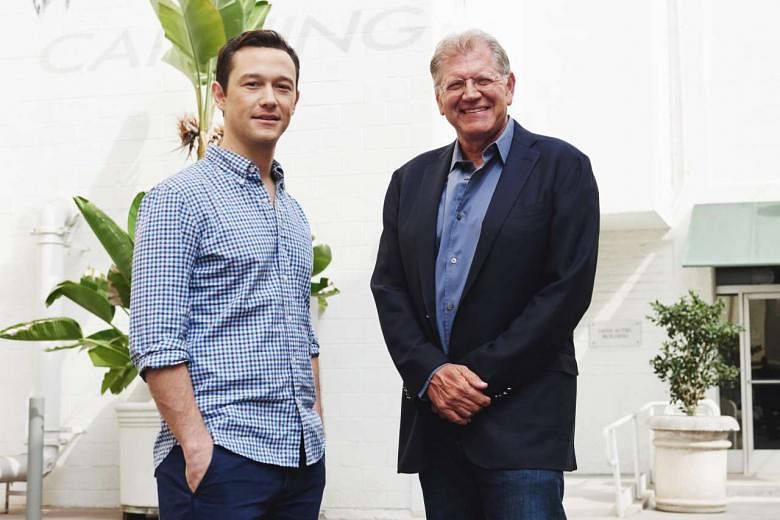NEW YORK • This autumn is the season of Robert Zemeckis, the 63-year-old Chicago-born writer- director who began making movies in the 1970s and changed American history, at least metaphorically, with his two huge hits, Back To The Future (1985) and Forrest Gump (1994).
The Walk, Zemeckis' 3-D reconstruction of Philippe Petit's high- wire stroll between the World Trade Center's twin towers in 1974, was chosen to open the New York Film Festival; special screenings and reissues will commemorate the 30th anniversary of Back To The Future; and starting tomorrow, the Museum of Modern Art presents a retrospective, What Lies Beneath, named for Zemeckis' 2000 psychological thriller.
The retrospective is his first, according to the film-maker, reached by telephone in Los Angeles.
What does lie beneath?
Although Zemeckis is notable for pioneering the use of digital cinema and computer-generated imagery, Dave Kehr, the curator who organised the show, called him "one of the last classical auteurs", a commercial director in the tradition of Howard Hawks or Alfred Hitchcock who is at once a popular artist and a personal film-maker.
Kehr takes the position that Zemeckis, who, beginning with Who Framed Roger Rabbit (1988), has been perhaps the most digitally adventurous of Hollywood film- makers, is unfairly dismissed as a technician and misleadingly typecast as a purveyor of feel-good entertainment.
A former critic who contributed to The New York Times, Kehr sees a darker world view. He has characterised Roger Rabbit, for example, as a caustic allegory of American race relations worthy of Mark Twain.
An old-school auteur, Zemeckis is loath to analyse his movies' themes and obsessions. In contrast to an American new wave film-maker such as Martin Scorsese, Zemeckis does not present himself as a cineaste.
He is also unsentimental about the fading away of 35mm film, a medium he last used in Cast Away (2000), around the time the Center for Digital Arts he helped finance opened at his alma mater, the University of Southern California. "I built a building," he said proudly.
The son of a construction worker, Zemeckis confounded his parents with his desire to become a film-maker.
The source of his inspiration was television. "As a kid, I watched everything," he said.
Did the continuous collage of fact and fiction, the intermingling of different periods and the endless recycling of TV encourage Zemeckis to envision American history as a spectacular flow of malleable media events?
This world view is most evident in Forrest Gump, in which the Candide-like protagonist (Tom Hanks) hobnobs with historical figures and is inserted into world- changing events. But it was already apparent in Zemeckis' first feature, the 1978 Beatlemania satire I Wanna Hold Your Hand, in which The Beatles were evoked with a combination of archival footage, doubles and vocal mimics.
Back To The Future and its sequels have a self-reflexive density suggestive of television (references to commercials abound while in the movies' Moebius-strip chronology, the pop-cultural artefacts of 1985 are foreshadowed in 1955 and vice versa); and by mixing animated characters with flesh- and-blood actors, Roger Rabbit offers a more abstract metaphor for people's lives among the media phantoms.
Similarly, Zemeckis' mystical science-fiction spectacular Contact (1997) enhanced its naturalism by featuring an abundance of actual TV reporters and other celebrities.
His characters are frequently isolated or alienated. It is striking that even in relatively naturalistic films such as What Lies Beneath and Cast Away, a remarkably bleak retelling of Robinson Crusoe, the protagonists attempt to connect to the world by forging emotional bonds with fantasy beings.
Whether Zemeckis identifies with these obsessed, solitary figures, including the tightrope-balancing hero of The Walk, he essentially puts his audiences in the same place: to watch a Zemeckis movie is often to enter a realm populated by non- existent humanoid creatures.
Combining his interest in history, flight, trauma and digital image- making, The Walk may be Zemeckis' quintessential movie. The Walk fabricates a no longer existing New York landscape and digitally, if subtly, modifies its human performers.
"Everything from a technical standpoint prepared me to do that movie," Zemeckis said.
In essence, he recreates Petit's mind-boggling stunt with his own high-wire act. The Walk documents the undocumentable and restores an absence, if only for a few hours.
NEW YORK TIMES

